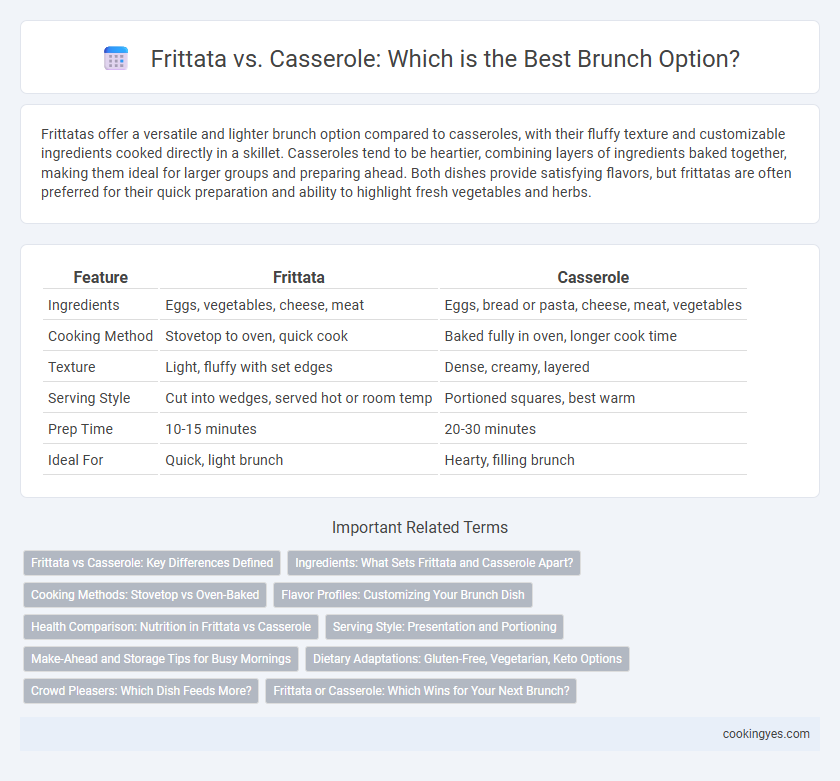Frittatas offer a versatile and lighter brunch option compared to casseroles, with their fluffy texture and customizable ingredients cooked directly in a skillet. Casseroles tend to be heartier, combining layers of ingredients baked together, making them ideal for larger groups and preparing ahead. Both dishes provide satisfying flavors, but frittatas are often preferred for their quick preparation and ability to highlight fresh vegetables and herbs.
Table of Comparison
| Feature | Frittata | Casserole |
|---|---|---|
| Ingredients | Eggs, vegetables, cheese, meat | Eggs, bread or pasta, cheese, meat, vegetables |
| Cooking Method | Stovetop to oven, quick cook | Baked fully in oven, longer cook time |
| Texture | Light, fluffy with set edges | Dense, creamy, layered |
| Serving Style | Cut into wedges, served hot or room temp | Portioned squares, best warm |
| Prep Time | 10-15 minutes | 20-30 minutes |
| Ideal For | Quick, light brunch | Hearty, filling brunch |
Frittata vs Casserole: Key Differences Defined
Frittata is an Italian egg-based dish cooked on the stovetop and finished in the oven, featuring a fluffy texture and visible chunks of vegetables, cheese, or meats, making it lighter than a casserole. In contrast, casseroles are baked dishes combining eggs with starches, dairy, and proteins, resulting in a denser, creamier consistency often served in larger portions. Nutritionally, frittatas tend to be lower in calories and carbs, offering a protein-rich, gluten-free option compared to casseroles that typically include bread or pasta for added bulk.
Ingredients: What Sets Frittata and Casserole Apart?
Frittatas primarily feature eggs as the base ingredient, combined with vegetables, cheeses, and sometimes meats, resulting in a cohesive, fluffy texture. Casseroles often incorporate a starch such as pasta, rice, or potatoes along with a creamy or saucy binder like condensed soup or bechamel, creating a layered, hearty dish. The distinct ingredient compositions define the frittata's light, protein-rich profile versus the casserole's denser, carbohydrate-forward structure ideal for brunch variety.
Cooking Methods: Stovetop vs Oven-Baked
Frittatas are primarily cooked on the stovetop, allowing for gentle, controlled heat that preserves the texture of eggs and ingredients while enabling quick customization with added vegetables or cheese. Casseroles, baked in the oven, provide even, consistent heat that melds flavors over a longer cooking time and creates a firm, cohesive dish ideal for serving larger groups. The stovetop method for frittatas offers a faster, more hands-on approach, while casseroles benefit from the slow, uniform warmth of oven baking, making each technique suited to different brunch preferences.
Flavor Profiles: Customizing Your Brunch Dish
Frittatas offer a delicate, egg-forward flavor that absorbs and highlights fresh herbs, cheeses, and vegetables, creating a light yet richly textured dish ideal for customizable seasoning. Casseroles present a heartier, layered taste experience with baked ingredients like meats, cheeses, and starches melding together, resulting in a comforting, savory profile. Choosing between a frittata and casserole allows brunch hosts to tailor the flavor intensity and texture, catering to preferences for either a fresh, vibrant meal or a robust, filling entree.
Health Comparison: Nutrition in Frittata vs Casserole
Frittatas typically contain whole eggs, fresh vegetables, and lean proteins, offering high-quality protein, essential vitamins, and lower carbohydrate content compared to casseroles. Casseroles often include heavier ingredients like cream, cheese, and processed meats, resulting in higher saturated fat and calorie levels. Choosing a frittata for brunch supports a balanced intake of nutrients while promoting heart health and weight management.
Serving Style: Presentation and Portioning
Frittatas offer a visually appealing, individual slice presentation ideal for elegant brunch settings, with each portion easily cut and served directly from the skillet or baking dish. Casseroles, typically served in larger, family-style portions, require scooping into plates, which can be less precise and visually uniform than frittata slices. The structured, firm texture of frittata allows for neat, consistent portions, enhancing presentation and ease of serving at casual or formal brunches.
Make-Ahead and Storage Tips for Busy Mornings
Frittatas offer excellent make-ahead convenience, as they can be prepared the night before and stored in the refrigerator for up to 3 days, making them ideal for busy brunch mornings. Unlike casseroles, frittatas reheat quickly and retain a light, fluffy texture without becoming soggy, ensuring a fresh-tasting meal. For optimal storage, cover the frittata tightly with plastic wrap or foil and reheat in a low-temperature oven or microwave to prevent overcooking.
Dietary Adaptations: Gluten-Free, Vegetarian, Keto Options
Frittatas naturally lend themselves to gluten-free, vegetarian, and keto-friendly dietary adaptations due to their base of eggs and customizable ingredients like vegetables, cheese, and meats. Casseroles can also be adapted but often require modifications to avoid gluten-containing breadcrumbs or starches, and may be less keto-friendly depending on added ingredients like bread or potatoes. Both dishes offer versatile brunch options, but frittatas are typically simpler for maintaining specific dietary restrictions without extensive ingredient substitutions.
Crowd Pleasers: Which Dish Feeds More?
Frittatas typically serve 6 to 8 people, making them ideal for smaller brunch gatherings, while casseroles can feed 8 to 12 or more, perfect for larger crowds. Frittatas offer quick preparation with customizable ingredients, but casseroles provide a more filling, hearty option that can be prepared in advance. For feeding a bigger group efficiently, casseroles generally prove to be the better crowd-pleaser due to their volume and ease of serving.
Frittata or Casserole: Which Wins for Your Next Brunch?
Frittatas offer a lighter, protein-packed option with eggs, vegetables, and cheese, perfect for those seeking a nutritious and customizable brunch dish. Casseroles tend to be heartier, often combining multiple ingredients like pasta, meats, and heavy sauces, making them suitable for feeding larger groups or those craving comfort food. When choosing between a frittata and a casserole for brunch, consider ease of preparation and desired portion size, as frittatas cook quickly and can be served individually, while casseroles typically require longer baking and are served family-style.
Frittata vs Casserole for brunch options Infographic

 cookingyes.com
cookingyes.com